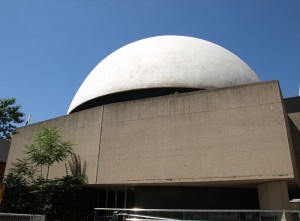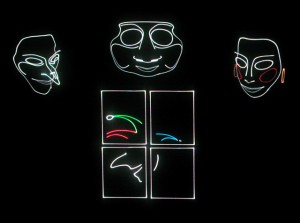
by Shamim Ahad simpsons movie the download
These days, the Daniel Libeskind expansion of the Royal Ontario Musem (ROM) probably gets the most press. However, the ROM also used to be home to one of North America’s most famous planetariums. The McLaughlin Planetarium sits with its iconic dome south of the ROM, off University Avenue. Although retired from its planetarium duties since 1995, it remains an important part of Toronto’s scientific past.
In 1962, all the stars were aligned to make the possibility of a Toronto planetarium a reality. First, a former member of the Royal Astronomical Society of Canada (RASC) left a small bequest for planetarium purposes. Then the University of Toronto, as the principal owner and operator of the ROM, donated land free of charge so that a planetarium could be built. However without a significant source of external funding, constructing the building would be difficult. Enter philanthropist Colonel R. Samuel McLaughlin. Inspired by the Hayden Planetarium in New York, McLaughlin contributed $2 million for construction costs, and provided an additional ongoing endowment of $1.15 million.
The building, completed on October 26, 1968, was designed by architects Allward &Gouinlock and by the engineering firm Stone and Webster Canada, Ltd. The original building concept included plans for a multi-story parking garage, a 550-seat conventional movie theatre, and a direct underground link to the Museum subway stop. Due to financial constraints, these ideas never came to fruition.
The planetarium consisted of four floors. In addition to basement storage space, the first floor was used to manage the influx of visitors and displayed a prominent bust of Colonel McLaughlin. The second floor consisted of a gallery called the “Astrocentre” which showcased space-related exhibits, astronomical artifacts as well as the world’s first commercial Stellarium. The third floor housed the facility’s most impressive feature: a state-of-the-art electro-mechanical Zeiss planetarium projector.
Imported from Jena (located at the time in the former East Germany), the planetarium projector was 4.0 m (13 feet) long. Shaped like a dumbbell, it had two 740 mm (29 inches) diameter spheres at each end. These represented the night sky for the northern and southern hemispheres. In order to project the planets, the Sun, and specific stars, a complex framework consisting virtually of 150 individual projectors was required. In time, several improvements were made that allowed for an increasing number of special effects such as recreating solar or lunar eclipses or close-ups of specific planets.
By the middle of the 1970s, an increasing number of automation features were added. These enhancements led to the creation of pre-recorded shows. Typically, automated audio/visual shows devoted to particular space-related topics would last 40 to 45 minutes. Themes included space travel and the mythical roots of the constellations. Around Christmas-time, there was a special show that explored theories on stellar explanations for the Star of Bethlehem.
In the early 1980s, the planetarium began hosting popular laser light shows on the third floor which was redubbed the “Laserium”. The shows

Image Capture from Bohemian Rhapsody. Photo Credit:Audio Visual Imagineering, 2009
were provided by the Florida-based firm Audio Visual Imagineering. Programs included “Laser Floyd: Dark Side of the Moon”, “Laser Depeche Mode” and “Laser Nirvana”. The second floor Astrocentre was revamped to house a 50-seat mini-theatre, wall murals illustrating the phases of the moon and a growing number of hands-on exhibits and interactive computer-driven displays.
Although there have been fluctuations in the planetarium’s popularity over the years, provincial budget cuts under Mike Harris’ Tory government forced the planetarium to close for good in 1995. Given that attendance had rebounded in recent years and that the planetarium making money, the closure came a surprise to many. The RASC salvaged some of the signs and paintings. These are on display at the E.C. Carr Astronomical Observatory. The original Zeiss-Jena projector was bought as a museum piece by York University for the sum of $1and placed into storage. The Children’s Own Museum took over the space until 2002, and thereafter it was used as office and storage space.
Since the planetarium shut down, some groups have advocated for its reopening. Initial efforts focused on reopening the existing facility, but the most recent campaigns are focuses on opening a new building elsewhere in downtown Toronto. In 2004-2005, ROM directors stirred up some controversy while they sought funding for the second expansion phase at the museum. They were entertaining a proposal to build luxury condominiums on the planetarium site which they eventually dropped due to vocal public opposition to tall buildings in a predominantly low-rise neighbourhood.
